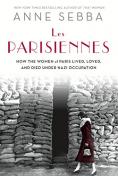
by Anne Sebba
Hardcover- $14.63
“Anne Sebba has the nearly miraculous gift of combining the vivid intimacy of the lives of women during The Occupation with the history ...
Overall rating:
How would you rate this book?
Member ratings
As this was an ARC from Bookbrowse the pictures which will be in the published edition were lacking and that is sad, for the captions of the empty spaces indicate that they will greatly enhance this story of the incredible women who lived through the German occupation of Paris and the rest of France during WW II. There are places where the story drags and others where the story is repetitious but overall it is a fascinating story.
It begins in 1939 when the City becomes aware of the German threat but during the lull when the Germans are gracious and cultured and polite. Soon things begin to change and the food shortages begin and Jews are rounded up and made to wear yellow stars, Jewish companies are aranized and their owners flee or to into hiding. Many French men have already gone to unoccupied France to fight in DeGualle's army, what few are left are gathered up and sent to work in Germany for the war effort.
Left behind are the women and children, whom they need to protect and feed. The choices made by the women are unbelieveable--some resist, some depart and others collaborate--some even collaborate while also resisting. All of the stories are heart-breaking and over and over I asked myself, what would I do, would I be able to survive some of the horrors , how would I protect my child?
Once liberation comes the story is far from over. All of the women who survived, no matter how, now had to face the future--for some a very short future, with death the result of trials that found them guilty of treason, or the result of illness and weakness resulting from years spent at the hands of brutal German imprisonment. Yet, others lived into their nineties and they, too, found their future shadowed by the years of the war and its aftermath.
Perhaps the most impressive line in the book is its last:"It is not for the rest of us to judge but, with imagination, we can try to understand." ( BTW, Liz Taylor was British--maybe American later.)
I was looking forward to reading this book. I read Kristin Hannah’s “The Nightingale” which piqued my interest in how the women in France survived Nazi occupation. I also read CW Gortner’s “Mademoiselle Chanel” which had a lot of information on how she and others like her survived.
This nonfiction book was well researched for the period 1939 – 1949. The majority of the book addresses the lives of “the rich and the famous” and, I admit, I scanned much of those sections. I was more interested in the everyday people, people like me. I also was not impressed with how much fashion – and entertainment to some degree - continued to be of prime importance during that time. Seems a bit shallow to me when people were just trying to survive.
Life did change for everyone, especially the women. Most of the men went away to war, leaving the women behind to carry on with live the best way they could. And it was indeed a difficult time. Food and other necessities of life were in very short supply. The Germans were the only ones that could afford food – or they just took it. Women faced daily humiliation as they had to queue for hours and then beg (and pay) for the few rations that were available.
Tremendous efforts were made to hide works of art – those in galleries and private Jewish collections. Part of Hitler’s plan was the intention to destroy any sense of belonging by depriving Jews of what they owned. He planned to create his own art gallery.
The British were using women in combatant activities, although it was forbidden by the Geneva Convention. Thus, these women had no protection if they were captured. History has failed to note that many women were among those deported.
When the war was over people who survived were suspected of being collaborators with the Germans. Jews, political prisoners, and prisoners of war recently liberated from camps and prisons, poured into the city – a city in no way ready to accommodate them. Many returned with serious medical issues that Paris was ill prepared to deal with. Perhaps most devastating was that many returned to find that everything they had owned had been taken.
In an effort to try to return to “normal”, women were encouraged to “return to a time of innocence and femininity, to stop making decisions, stop balancing cheque books, stop being aggressively punctual.” This met with mixed responses.
I liked the discussion of what it takes to be a hero. I think I agree with this statement in the book: “Heroism isn’t a matter of choice, but of reflex. It’s a property of the central nervous system, not the higher brain.” Heroes do not think; they act.
This is a book well worth reading, even though it does bog down at times. More and more people are now finally talking about what really happened during the Nazi Occupation. For a long time no one wanted to hear about it so the survivors kept quiet. Now their stories are being told – and heard.
I received an advance copy from St. Martin’s Press vis BookBrowse in return of an honest review.
Book Club HQ to over 90,000+ book clubs and ready to welcome yours.
Get free weekly updates on top club picks, book giveaways, author events and more








